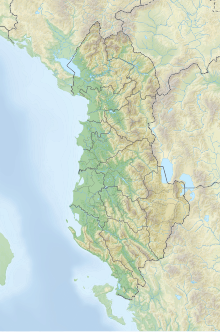Battle of Butrint (1798)
| Battle of Butrint | |||||||||
|---|---|---|---|---|---|---|---|---|---|
| Part of the War of the Second Coalition | |||||||||
| |||||||||
| Belligerents | |||||||||
|
Pashalik of Yanina Albanian bashi-bazouks | First French Republic | ||||||||
| Commanders and leaders | |||||||||
| Ali Pasha of Ioannina | Nicolas Grégoire Aulmont de Verrières | ||||||||
| Strength | |||||||||
| Unknown | est. 300 French soldiers | ||||||||
| Casualties and losses | |||||||||
| Unknown | 50 killed, many evacuated to Corfu | ||||||||
Location of Butrint within modern-day Albania | |||||||||
The Battle of Butrint occurred between 18 and 25 October 1798, during the broader context of conflicts associated with the War of the Second Coalition. Ali Pasha,[1] a powerful Ottoman vassal of Albanian descent,[2] sought to extend his influence over the coastal areas of southern Albania[3] and to challenge the French occupation of Butrint. This confrontation resulted in an Albanian victory after the French forces, significantly outnumbered, were defeated and forced to evacuate to Corfu.
Background
[edit]Following the Treaty of Campo Formio in 1797,[4] the Ionian Islands and nearby coastal territories that were formerly Venetian came under French control.[5][6] These territories included Butrint, a fortified town located on the southern Albanian coast. The French garrison at Butrint was part of a strategic chain of outposts intended to secure French influence in the region.
Ali Pasha, ruler of the Pashalik of Yanina,[7] had become increasingly powerful by this time.[8] Known for his military prowess and territorial ambition, Ali Pasha saw the French presence in Butrint as a challenge to his authority. He sought to assert control over this key strategic location in southern Albania, which would help expand his influence in the Balkans.
As the French were distracted by other conflicts across Europe, the garrison in Butrint was left relatively isolated and vulnerable to attack.[9]
The invasion
[edit]On 18 October 1798, Ali Pasha led an army of unknown numeber of Albanian troops in an assault on the French-held town of Butrint. The French garrison, commanded by général de brigade Nicolas Grégoire Aulmont de Verrières,[10] numbered around 300 soldiers and was significantly outnumbered.
Despite attempts to hold off the Albanian forces, the French troops were overwhelmed by the size and strength of the attacking force. The Albanians, skilled in guerrilla warfare and familiar with the region, used their superior numbers and tactics to slowly press the French into retreat.
By 25 October 1798, after seven days of fighting, the French defenses were breached, and it became clear that the garrison could not hold the town.[11]
Evacuation and aftermath
[edit]Recognizing the futility of further resistance, général de brigade Aulmont de Verrières ordered the destruction of Butrint's fortifications to deny Ali Pasha's forces the ability to utilize them. He also oversaw the evacuation of the surviving French soldiers and many of the town's Greek[12] inhabitants to Corfu,[13] an island still under French control.[14][15]
In total, the French forces suffered about 50 casualties during the battle, with the remainder of their soldiers and the civilian population escaping to Corfu.[16] Although the Albanian forces' casualties are unknown, they were believed to have been minimal.[17]
Ali Pasha's[18] capture of Butrint was part of his broader efforts to consolidate control over southern Albania. This victory significantly weakened the French presence in the region, and furthered his ambitions of territorial expansion.[19]
See also
[edit]- Ali Pasha of Ioannina
- Pashalik of Yanina
- French First Republic
- Albanian Pashaliks
- History of Albania
References
[edit]- ^ Russell, Quentin; Russell, Eugenia (2017). Ali Pasha, Lion of Ioannina: The Remarkable Life of the Balkan Napoleon. Pen & Sword Military. ISBN 978-1473877207.
- ^ Miranda Vickers (1995). Miranda Vickers - The Albanians: A Modern History.
- ^ Papageorgiou, Stefanos P. (2014-05-21). "The attitude of the Beys of the Albanian Southern Provinces (Toskaria) towards Ali Pasha Tepedelenli and the Sublime Porte (mid-18th-mid-19th centuries)". Cahiers balkaniques. 42. doi:10.4000/ceb.3520. ISSN 0290-7402.
- ^ "Treaty of Campo Formio 1797". www.napoleon-series.org. Retrieved 2024-09-09.
- ^ The Ionian Islands
- ^ https://www.hup.harvard.edu/books/9780674988385
- ^ Miller, William (9 September 1966). The Ottoman Empire and Its Successors, 1801-1927. Psychology Press. ISBN 0714619744.
- ^ Stavrianos, Leften Stavros (2000). The Balkans since 1453. Internet Archive. New York : New York University Press. ISBN 978-0-8147-9766-2.
- ^ academic.oup.com https://academic.oup.com/book/37426/chapter-abstract/331513910?redirectedFrom=fulltext. Retrieved 2024-09-09.
{{cite web}}: Missing or empty|title=(help) - ^ Broers, Michael (30 January 2017). The Napoleonic Mediterranean: Enlightenment, Revolution and Empire. Bloomsbury Academic. ISBN 978-1784531447.
- ^ Fischer, Bernd J.; Schmitt, Oliver Jens (2022-09-29). A Concise History of Albania. Cambridge University Press. ISBN 978-1-009-25490-8.
- ^ https://www.amazon.it/Greeks-Professor-Prof-Roderick-Beaton/dp/0571353576
- ^ Greek-Albanian Relations, the Past, the Present and the Future
- ^ "https://www.thethinkingtraveller.com/greece/ionian/https//www.thethinkingtraveller.com". The Thinking Traveller. Retrieved 2024-09-09.
{{cite web}}: External link in|title= - ^ Abulafia, David (2011-10-13). The Great Sea: A Human History of the Mediterranean. Oxford University Press, USA. ISBN 978-0-19-532334-4.
- ^ Vakalopoulos, Apostolos Euangelou (1963). A History of Thessaloniki. Institute for Balkan Studies.
- ^ https://theses.hal.science/tel-02160100/file/2014-06-JESTIN-Salonique.pdf
- ^ Russell, Quentin; Russell, Eugenia (2017-09-30). Ali Pasha, Lion of Ioannina: The Remarkable Life of the Balkan Napoleon. Pen and Sword. ISBN 978-1-4738-7722-1.
- ^ Michael (2013-12-05). "Albanian History". Left side of the road. Retrieved 2024-09-09.
Further reading
[edit]- Bellaire, J. P. (1805). Précis des opérations générales de la division française du Levant (in French). Paris.
- Masson, Frédéric (1894). "Le Combat de Nicopolis (1799) d' après les mémoires du général Camus de Richemont". Aventures de Guerre 1792-1809: Souvenirs et récits de soldats, recueillis et publiés par Frédéric Masson, illustré par F. de Myrbach (in French). Paris: Bousson, Valadon & Cie. pp. 71–89.

